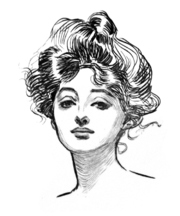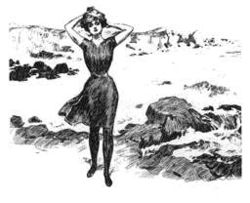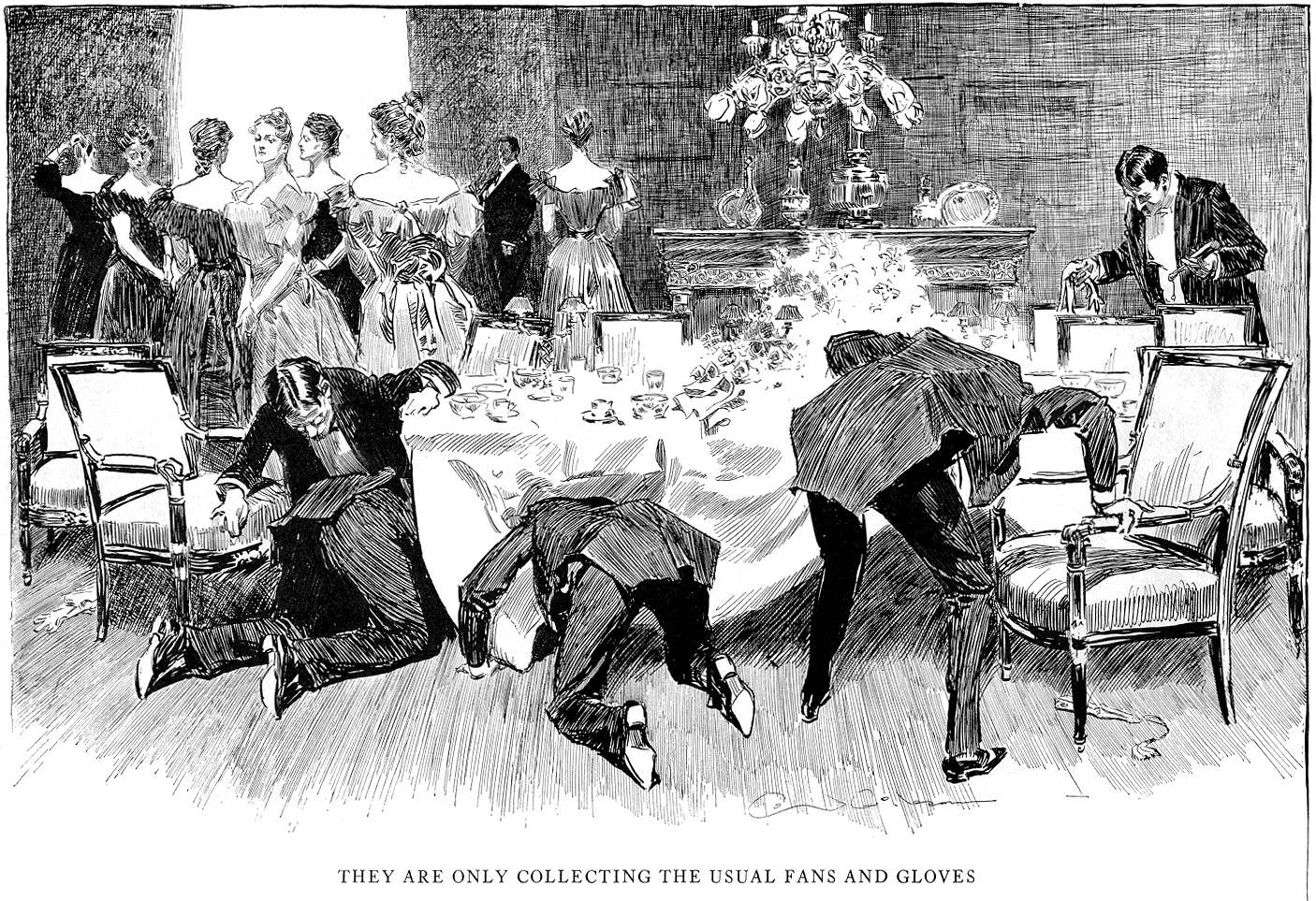
Gibson Girl
Encyclopedia

Illustrator
An Illustrator is a narrative artist who specializes in enhancing writing by providing a visual representation that corresponds to the content of the associated text...
Charles Dana Gibson
Charles Dana Gibson
Charles Dana Gibson was an American graphic artist, best known for his creation of the Gibson Girl, an iconic representation of the beautiful and independent American woman at the turn of the 20th century....
during a 20-year period spanning the late nineteenth and early twentieth century in the United States.
Some people argue that the "Gibson Girl" was the first national standard for feminine beauty. For the next two decades, Gibson's fictional images were extremely popular. There was merchandising of "saucers, ashtrays, tablecloths, pillow covers, chair covers, souvenir spoons, screens, fans, umbrella stands", all bearing her image. The artist saw his creation as representing "thousands of American girls".
The image

Corset
A corset is a garment worn to hold and shape the torso into a desired shape for aesthetic or medical purposes...
. The images of her epitomized the late 19th- and early 20th-century Western preoccupation with statuesque, youthful features and ephemeral beauty. Her neck was thin and her hair piled high upon her head in the contemporary bouffant
Bouffant
A bouffant is a type of hairstyle characterized by hair piled high on the head and hanging down on the sides.-History:The bouffant was a mainstream hairstyle in the mid-to-late 18th century in western Europe. It was thought to be created for Marie Antoinette, as she had relatively thin hair and...
, pompadour
Pompadour (hairstyle)
Pompadour is a tall style of men's haircut which takes its name from Madame de Pompadour.There are Latin variants of the hair style more associated with European and Argentine tango fashion trends and occasionally with late 20th century musical genres such as rockabilly and country.The pompadour...
, and chignon
Chignon (hairstyle)
A chignon is a popular type of hairstyle. The word “chignon” comes from the French phrase “chignon du cou,” which means nape of the neck. Chignons are generally achieved by pinning the hair into a knot at the nape of the neck or at the back of the head, but there are many different variations of...
("waterfall of curls") fashions. The tall, narrow-waisted ideal feminine figure was portrayed as being multi-faceted, at ease, and fashionable. Gibson depicted her as an equal and sometimes teasing companion to men.
The artist believed that the Gibson Girl represented the beauty of American women:
Gibson believed that America's Gibson Girls would become more beautiful:
Many models posed for Gibson Girl-style illustrations, including Gibson's wife, Irene Langhorne (who may have been the original model, and was a sister of Nancy Astor, Viscountess Astor
Nancy Astor, Viscountess Astor
Nancy Witcher Astor, Viscountess Astor, CH, was the first woman to sit as a Member of Parliament in the British House of Commons.Constance Markievicz was the first woman elected to the House of Commons in December 1918 after running for the Sinn Féin party in 1918 General Election, but in line...
) and Evelyn Nesbit
Evelyn Nesbit
Evelyn Nesbit was an American artists' model and chorus girl, noted for her entanglement in the murder of her ex-lover, architect Stanford White, by her first husband, Harry Kendall Thaw.-Early life:...
.
The most famous Gibson Girl was probably the Belgian-American stage actress, Camille Clifford
Camille Clifford
Camilla Antoinette Clifford was a Belgian-born stage actress and the most famous model for the "Gibson Girl" illustrations. Her towering coiffure and hourglass figure defined the Gibson Girl style....
, whose high coiffure and long, elegant gowns that wrapped around her hourglass figure and tightly corseted wasp waist
Wasp waist
Wasp waist refers to a woman's fashion silhouette, produced by a style of corset and girdle, that has experienced various periods of popularity in the 19th and 20th centuries. Its primary feature is the abrupt transition from a natural-width rib cage to an exceedingly small waist, with the hips...
defined the style.
Among Gibson Girl illustrators were Howard Chandler Christy
Howard Chandler Christy
Howard Chandler Christy was an American artist and illustrator famous for the "Christy Girl", similar to a "Gibson Girl".He was born in Morgan County and attended early school in Duncan Falls, Ohio...
whose work celebrating American "beauties" was similar to Gibson's, and Harry G. Peter, who was most famous for his art on Wonder Woman
Wonder Woman
Wonder Woman is a DC Comics superheroine created by William Moulton Marston. She first appeared in All Star Comics #8 . The Wonder Woman title has been published by DC Comics almost continuously except for a brief hiatus in 1986....
comics.

Suffragette
"Suffragette" is a term coined by the Daily Mail newspaper as a derogatory label for members of the late 19th and early 20th century movement for women's suffrage in the United Kingdom, in particular members of the Women's Social and Political Union...
movement), and American national prestige. By the outbreak of World War I
World War I
World War I , which was predominantly called the World War or the Great War from its occurrence until 1939, and the First World War or World War I thereafter, was a major war centred in Europe that began on 28 July 1914 and lasted until 11 November 1918...
, changing fashions caused the Gibson Girl to fall out of favor. Women of the World War I era favored a practical, more masculine suit, compatible with war work, over the elegant dresses, bustle gowns, shirtwaists, and terraced, shorter skirts favored by the Gibson Girl.
Survival radio
The USAAF World War IIWorld War II
World War II, or the Second World War , was a global conflict lasting from 1939 to 1945, involving most of the world's nations—including all of the great powers—eventually forming two opposing military alliances: the Allies and the Axis...
-era SCR-578 (and the similar post-war AN/CRT-3) survival radio transmitters carried by aircraft on over-water operations were given the nickname "Gibson Girl" because of their "hourglass" shape. The radio included a balloon with water-activated hydrogen inflator and a fold-up/down metal frame box kite for which the flying line was an aerial wire. A hand-crank generator provided power for the distress radio signal.
When the user was seated in an inflatable life boat, the "Gibson Girl" shape of the radio allowed it to be held stationary, between the legs and above the knees, while the generator handle was turned. The distress signal, in Morse code, was produced automatically as the handle was turned. A similar design was used by the German Luftwaffe
Luftwaffe
Luftwaffe is a generic German term for an air force. It is also the official name for two of the four historic German air forces, the Wehrmacht air arm founded in 1935 and disbanded in 1946; and the current Bundeswehr air arm founded in 1956....
circa 1939.
Further reading
- Patterson, Martha H. Beyond the Gibson Girl: Reimagining the American New Woman, 1895-1915. University of Illinois Press, 2005.
- Patterson, Martha H. The American New Woman Revisited: 1894-1930. New Brunswick: Rutgers University Press, 2008.

